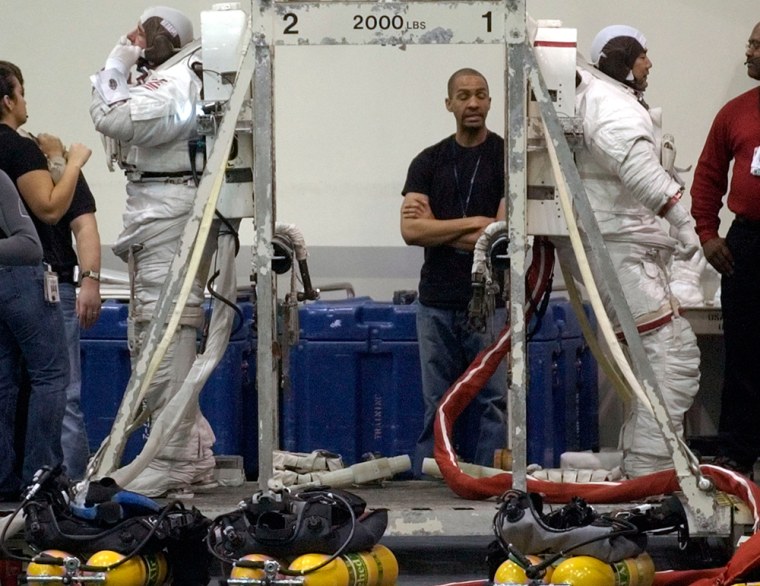Two astronauts took the plunge today during a training exercise for one of three critical spacewalks to repair the International Space Station (ISS) and test new techniques for fixing heat-resistant tiles during NASA’s first shuttle launch since the Columbia accident.
NASA astronaut Stephen Robinson and Soichi Noguchi, of the Japanese Aerospace Exploration Agency (JAXA), spent more than five hours underwater at the Neutral Buoyancy Center near Johnson Space Center here rehearsing the spacewalk.
Today’s test run -- the goal of which was to replace a broken gyroscope with a fresh unit -- went smoothly, but Discovery astronauts said more training is still needed before Noguchi and Robinson will be ready to test two methods to repair damaged shuttle tiles and cracks in the thermal protection panels made of reinforced carbon carbon.
“Most of the EVA you saw today is practicing and rehearsing stuff we’ve done before,” said STS-114 pilot James Kelly, who participated in today’s rehearsal from the spacewalk control room. “On our EVA 1 and 3, we still have some things that are unknown, mostly things to do with tile repair and RCC repair.”
Training for repairs
It was damage to the space shuttle Columbia’s RCC panels along a wing leading edge -- sustained during launch when a chunk of foam broke of the orbiter’s external tank -- that allowed hot gases to enter the wing and destroy the spacecraft during reentry on Feb. 1, 2003. Since the accident, researchers and engineers have been working to develop in-space methods to detect and repair such damage should it be necessary.
Veteran astronaut Eileen Collins, commander of the STS-114 mission, told reporters that while she is fully confident that Discovery’s spaceflight will be the safest ever to fly, she does not believe that the tile and RCC repair techniques are mature enough to rely on should the flight require putting them in practice.
“Until we actually fly them in space and test them will [the repair techniques] really be certified,” Collins said.
During the STS-114 spaceflight, Noguchi and Robinson are slated to test the a black, putty-like substance that can be slathered onto cracks in RCC panels, as well as another technique called Emmitance Wash Application, where a gray substance is dabbed onto damaged tiles to shore up their heat protection qualities.
But Robinson agreed with his flight commander that those initial tests should not be pressed into action if repairs prove necessary aboard Discovery.
“We don’t want to have the first test be with us inside,” he said.
Other untested methods of tile and RCC repair may be on hand during Discovery’s mission, but will not be tested by the spacewalking duo, NASA officials said.
A smooth, wet rehearsal
For today’s spacewalk rehearsal -- one of many for Noguchi and Robinson - the two astronauts donned training versions of U.S. spacesuits and entered the mock-space environment of NASA’s Neutral Buoyancy Laboratory -- a vast pool containing large models of the ISS and shuttle payload bay -- at about 9:55 a.m. EST (1455 GMT).
Five hours and 20 minutes later, they emerged after a long day of faux-spacewalking.
“Thanks for the great work guys,” Noguchi told EVA controllers near the end of the rehearsal.
The spacewalk is set to be the second of a trio of extravehicular activities (EVAs) for Robinson and Noguchi during the STS-114 mission aboard the Discovery orbiter, NASA’s first shuttle flight since the 2003 loss of Columbia and its
During the spacewalk rehearsal, Noguchi and Robinson practiced replacing a device called a control moment gyroscope (CMG) used by the ISS to maintain its position in space. The space station relies on four such gyroscopes for orientation, with two serving as spares. One of the devices -- the one Noguchi and Robinson expect to replace -- failed in 2002.
While the STS-114 spacewalkers had run through the gyroscope repair before, today’s rehearsal was the first time they staged their EVA from Discovery’s airlock, rather than the space station airlock as originally planned.
“We’ve basically been learning more and more,” Robinson said. “It helps to have more things in our bag of tricks.”
